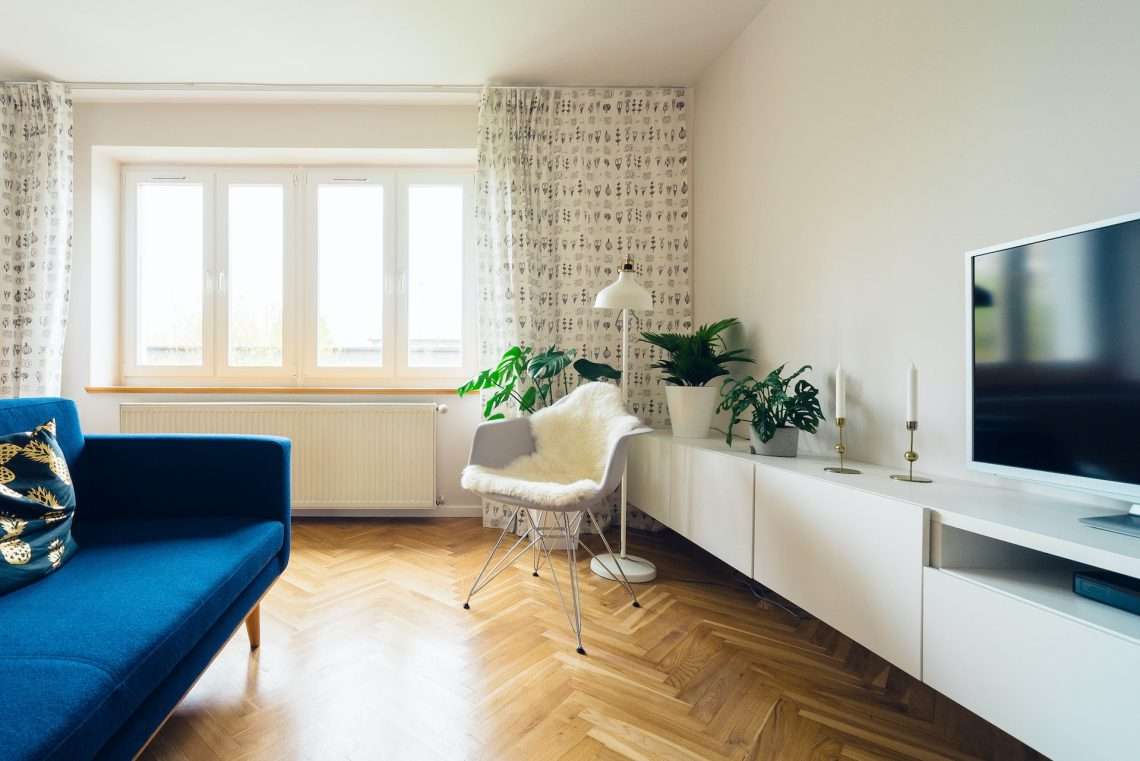
Biophilic Design: Incorporating Nature into Your Home
Ever feel more relaxed and energized when surrounded by nature? You’re not alone! Biophilic design, incorporating natural elements into our home environment, has grown increasingly popular over the last decade. From adding gorgeous green plants everywhere to incorporating natural materials such as wood and stone, biophilic design is a way to bring calming vibes, improved health benefits, and beautiful aesthetics into your space, all while connecting with mother earth. Read on to learn how you can easily add eco-friendly touches that truly embrace biomimicry in your home!
What is Biophilic Design?
Biophilic design is an approach to architecture and interior design that connects people with the natural world. It’s based on the idea that we have an innate need to be surrounded by natural elements such as plants, light, and water. Biophilic design principles are often used to create aesthetically pleasing and earth-friendly spaces.
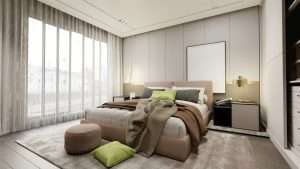
Incorporating elements of nature into the design of an interior can promote well-being and improve productivity. For example, an earth-friendly interior might include living walls, indoor gardens, and natural light sources that reduce energy consumption. By designing spaces that connect us to nature, we can create healthier and more sustainable environments that benefit both people and the planet.
Benefits of Biophilic Design
Connection with nature
Biophilic design connects with nature and helps us decrease stress levels. Studies have shown that people who spend time in nature report lower stress levels, improved mood, and increased productivity. By incorporating biophilic design elements into our environment, we can help to bring those benefits indoors. For example, the view of nature from a window, a living wall in a workspace, or a communal room with natural lighting can help to provide these benefits.
Improved air and water quality
Biophilic design elements can help to improve air and water quality in our interior spaces. Indoor plants can help to filter out toxins in the air, while water features such as fountains can help to improve humidity levels and air quality. This is especially important for those who live or work in urban areas, where air quality can be poor. Implementing biophilic design elements can help improve the inhabitants’ overall health and well-being.
Increased creativity and productivity
Biophilic design has been shown to impact creativity and productivity levels positively. Incorporating natural elements into our indoor spaces can help to reduce mental fatigue and increase focus, leading to increased creativity and productivity. For example, a workspace with natural lighting and greenery can help to improve employees’ creativity, making it an excellent investment for employers.
Reduced noise levels
Biophilic design elements can help to reduce noise levels in our indoor spaces, creating a calmer and more peaceful environment. For example, using natural materials such as wood can help absorb sound, reducing the echo in a room. Installing a green wall in a workspace can also help to reduce noise levels and improve the overall ambience.
Incorporating Natural Light into Your Home
The key to incorporating natural light into your home is to maximize the amount of daylight that enters your living spaces. The first step is to ensure that your windows are positioned in areas with ample sunlight. Large windows, skylights, and glass doors are great ways to bring in more natural light. Once you have positioned your windows, you can amplify their effect by using light-coloured walls, ceilings, and furniture to reflect the light more effectively.
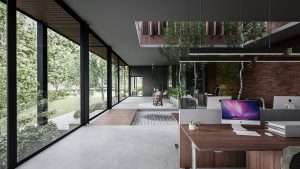
Natural light can also be optimized by carefully selecting room materials and furniture. Materials like wood, stone, and other natural elements can reflect the light in a way that creates a soothing and uplifting ambience. Similarly, incorporating plants and greenery in your living spaces can significantly enhance the biophilic effect of natural light. Plants provide a visual appeal and help regulate indoor air quality, improve mood, and reduce stress.
Another effective strategy for increasing natural light is to use curtains and blinds to control the amount of sunlight entering your home. You can choose lightweight curtains that diffuse the light or sheer curtains that let more light through. Blinds can filter the sunlight effectively, giving you more control over the amount of natural light you want to let in.
Using Natural Materials in Home Design
Wood
Wood is possibly the most common and versatile natural material used in home design. One of the most popular applications of wooden material is wooden flooring. It can also be used for ceilings and furniture. The natural texture and grain of the wood add warmth and character to any room, and it’s also a sustainable material. Reclaimed or recycled wood is environmentally friendly and adds a unique and personal touch to any space.
Stone
Stone is another great natural material to incorporate into your home design. It has a timeless and classic appeal that can add a sense of luxury and sophistication to a space. Natural stones such as marble and granite are popular for kitchen countertops, while travertine and slate can create a stunning feature wall. Stone is durable and low maintenance, making it an excellent investment for any home.
Plants
Incorporating plants into your interior design scheme is another way to bring the outdoors in and create a calming atmosphere. They improve air quality, and plants add natural colour and texture to any room. You can choose from small potted plants or larger statement plants such as fiddle leaf figs or palms. Whether you place them on a windowsill, on a shelf or on the floor, plants can help to create a tranquil ambience in any space.
Natural Fibers
Natural fibres such as cotton, wool, and linen are perfect for creating a cosy and inviting space. These materials can be used for soft furnishings such as rugs, cushions, and throws. The texture and warmth of natural fibres create a homely feel and are perfect for snuggling up on the sofa or bed.
Indoor Plants: A Must-Have for Biophilic Design
For those looking to incorporate biophilic design principles into their space, indoor plants are a must-have. Plants have been shown to improve air quality, reduce stress, and increase productivity, making them a natural fit for any space. Not only that, but they’re also easy to incorporate and come in various sizes and styles. An indoor planter can add greenery and life to any room, whether a hanging plant or a potted tree.
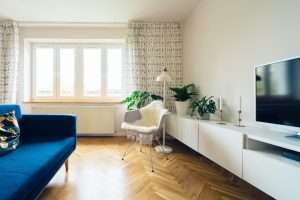
The biophilic design focuses on bringing nature indoors and incorporating plants effectively achieves that. By adding indoor plants, you not only create a visually appealing space but one that promotes well-being and relaxation. Whether in a small apartment or an ample office space, indoor plants can help create a connection with nature and bring balance to any environment.
Creating a Green Wall in Your Home
A green wall is a great way to add visual interest and texture to an interior space. This can be achieved through indoor vertical planters and living or moss walls. Green walls are an excellent choice for those looking to bring the outdoors in and create a calming atmosphere in their home. The natural colour and texture of the plants provide a unique aesthetic that can enliven any room.
Incorporating a green wall into your home design serves an aesthetic purpose and has numerous benefits for air quality. The plants absorb pollutants and release oxygen, making them an effective way to improve air quality in the home. Additionally, living walls are low maintenance and easy to care for, making them ideal for busy homeowners.
Biophilic Furniture and Accessories
Biophilic Furniture
For a natural and organic feel, it’s essential to incorporate wood, stone, and other natural elements into furniture design. Turn an ordinary coffee table into a statement piece by utilizing a slice of a tree trunk as the tabletop, or frame a statement mirror with reclaimed wood to mimic the texture of a forest. Organic forms such as branch-shaped coat racks or driftwood lamps can also contribute to the biophilic design approach.
Living Walls
Green or living walls are among the most effective ways to integrate plants into indoor spaces. These installations are vertical gardens with plants and flowers on an interior or exterior wall. They add visual interest and contribute to the biophilic ambience while improving air quality by filtering toxins from the air. Living walls can be custom-built to fit any space, from small panels for apartments to extensive installations in lobbies and atriums.
Natural Fibre Rugs
Area rugs are an excellent way to add texture and warmth to a room while giving the nod to biophilic design. Natural fibre rugs made from wool, sisal, and jute create a tactile, earthy feeling underfoot. In addition, these materials are often sustainable, eco-friendly, and biodegradable, which is a perfect fit for a biophilic design approach.
Potted Plants
Potted plants are the most accessible and affordable way to bring nature indoors. The biophilia hypothesis suggests that humans have an innate desire to connect with nature, and incorporating living plants as part of the design can help fulfil that need. Plants in decorative pots of various sizes can be strategically placed throughout the space to create visual interest and improve air quality.
Soundscapes and Aromatherapy in Biophilic Design
Soundscapes
Soundscapes are natural sounds that mimic those found in the environment, such as rustling leaves, bird songs, or water flowing. These sounds can have a significant impact on our psychological and physiological well-being. Research has shown that listening to natural sounds decreases stress levels, improves mood, and enhances cognitive performance. Moreover, soundscapes can bring the outside in and create a multisensory experience promoting calm and well-being.
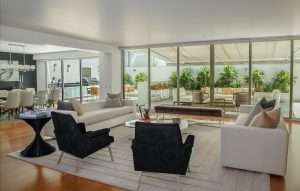
To incorporate soundscapes in your biophilic design, you can use speakers or sound-absorbing materials such as wood, stone, and fabrics to create an immersive experience. Natural sounds can be played throughout the day in a timed sequence or played on-demand through a dedicated interface. The selection of sounds can also vary depending on the location, time of day, and type of activity in the space. For example, bird songs could be played in the morning to promote wakefulness, while rainfall sounds could be played in the evening to promote relaxation.
Aromatherapy
Aromatherapy is a complementary therapy that uses plant extracts or essential oils to promote physical and psychological well-being. Inhalation of specific essential oils has been shown to reduce stress and anxiety levels, improve sleep quality, and boost cognitive performance. Additionally, many essential oils have anti-microbial properties that can help purify the air quality of a space.
To incorporate aromatherapy in your biophilic design, you can use a diffuser or a spray to disperse essential oils in a space. Certain oils, such as lavender and chamomile, are known for their relaxing properties and are ideal for bedrooms and relaxation areas. Other oils, such as peppermint and rosemary, are known for their invigorating properties and can be used in workspaces or areas where mental focus is required. It’s important to note that essential oils should be used cautiously, and proper dilution and selection should be considered based on individual preferences and health conditions.
Conclusion
Biophilic design is a holistic approach to interior design that incorporates natural elements and principles of sustainability. This approach can create spaces that are calming and relaxing and promote well-being. Incorporating natural light, natural materials, indoor plants, green walls, furniture, home accessories, aromatherapy, soundscapes and air quality can create a biophilic space. Optimizing colour psychology, texture, and pattern can enhance the space’s experience and create an aesthetically pleasing and emotionally fulfilling environment.




